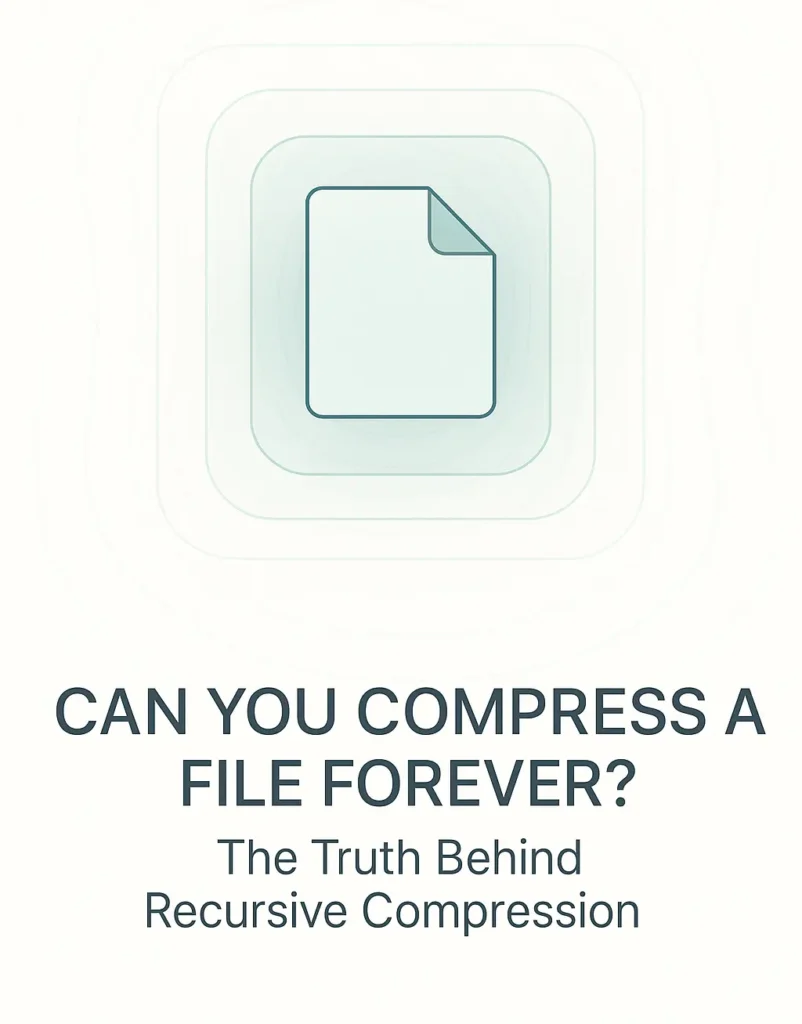Can You Compress a File Forever? The Truth Behind Recursive Compression
We all love shrinking files. Whether it’s uploading faster, saving bandwidth, or just fitting more into cloud storage — compression is essential. But here’s a question that’s fascinated people for years: Can you keep compressing a file forever to make it infinitely small?
It sounds like a cool idea — run your image or video through a compressor over and over again, each time slicing a few more bytes off. But is it actually possible? In this article, we’ll break down the reality of recursive compression, debunk myths, and explain why size has its limits.

What Is Recursive Compression?
Recursive compression refers to the idea of compressing an already compressed file again — and then repeating the process endlessly. It’s based on the hope that each pass squeezes out a little more redundancy.
It seems logical: if compression removes patterns and repetition, and you still have some patterns left, why not run the compressor again?
But the truth is, most modern compressors already do everything they can in a single pass.
Why Compression Has Limits
Compression works by finding redundancy in data — repeated patterns, predictable sequences, and unnecessary bits. Once those are removed, you’re left with the most efficient version of that data (within the rules of the format).
Once a file is compressed:
- Lossless formats like ZIP or PNG won’t shrink any further.
- Lossy formats like JPEG or MP3 may shrink a bit more, but quality degrades.
Trying to compress a ZIP file with another ZIP just adds overhead (and may even increase the file size).
The Mathematical Proof
Information theory (specifically Shannon’s entropy) tells us that there’s a minimum size below which you simply can’t go. Every file has a certain amount of information — once you’ve stripped away the structure and repetition, you can’t reduce it further without throwing away the content.
Think of it like squeezing a sponge: once all the water is out, pressing harder won’t make it any drier.
Recursive Compression in Practice
Some advanced compressors like PAQ or ZPAQ do use multiple layers of compression techniques. But even they don’t run forever — they eventually hit a wall. Each layer adds diminishing returns:
- 1st compression: shrinks 50%
- 2nd: maybe 5% more
- 3rd: just 1–2% (or even growth due to added metadata)
You reach a point where further attempts don’t help or may even increase file size due to the overhead of the extra compression layers.
Can AI Change This?
Some people believe that future AI-based compressors might spot smarter patterns and compress better. That’s partially true — machine learning models can make better guesses and custom-tailored compressors.
But even the smartest AI is bound by physics and math. It can optimize more efficiently, but it can’t beat entropy.
Fun Fact: The “Bzip2 Loop Joke”
Tech forums often joke about compressing a file over and over until it’s the size of a pixel. In reality, after a few rounds, the file either stays the same size or gets larger. Some formats like .tar.gz.bz2.7z.zip exist just to prove the absurdity!
Final Verdict
No, you can’t compress a file forever. Recursive compression is an illusion that breaks down when you understand how compression truly works. Once data is as efficient as possible, there’s nowhere left to go — unless you’re ready to sacrifice quality.
That said, tools like EzWayTool help you achieve optimal compression quickly and intelligently, without confusion or complexity.
👉 Try our smart online image compressor — one pass is all you need.
Compress smart. Not forever. — with EzWayTool.
